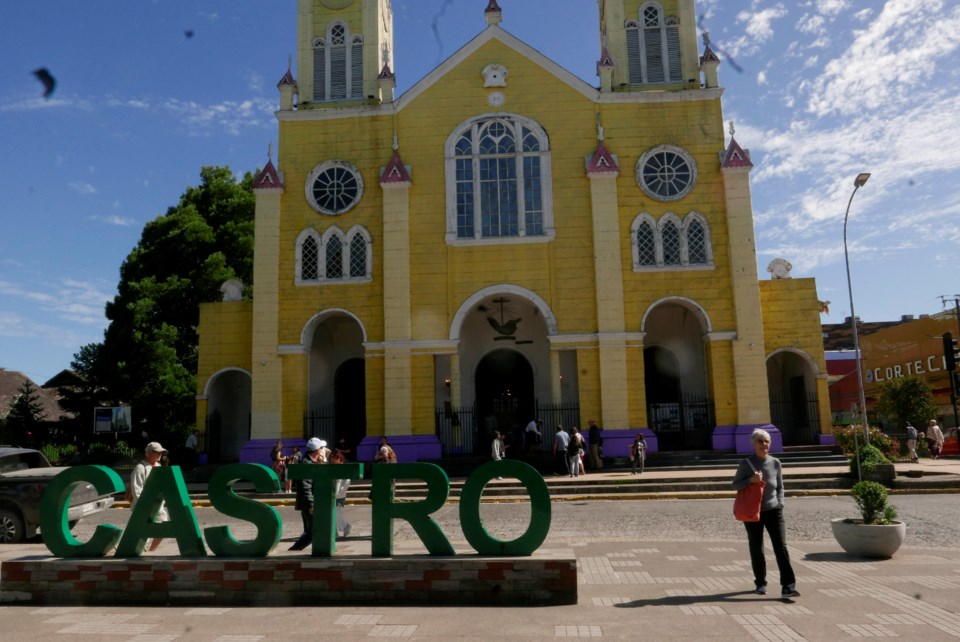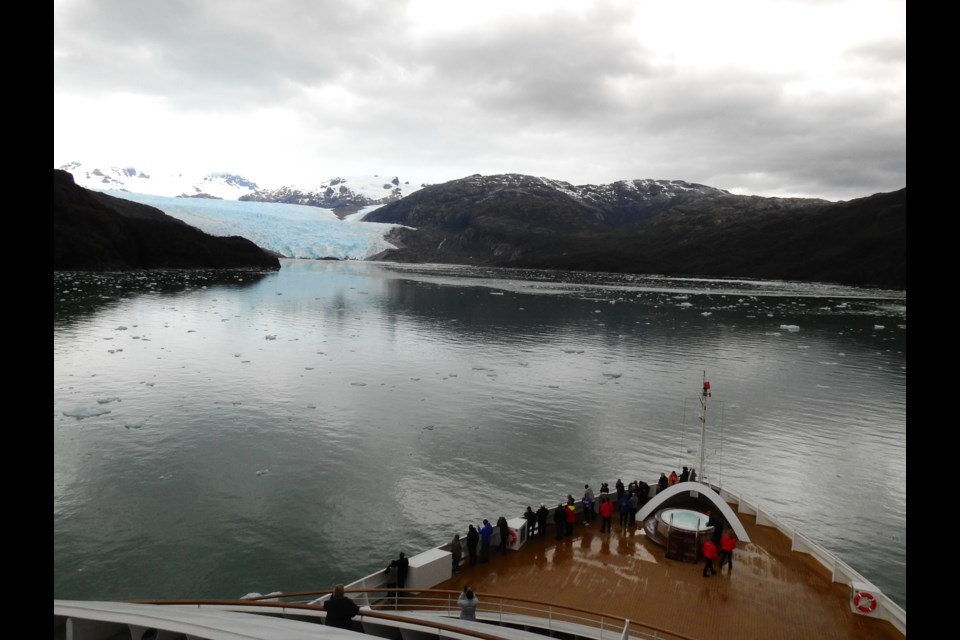The following column is from BarrieToday community advisory board member Peter Bursztyn about his trip south of the equator.
Many Canadians think about heading south during the winter. We did, but we overshot by several thousand kilometres. We are heading to the Antarctic Peninsula!
Our winter holiday began with a two-hour delay at Toronto Pearson Airport. Moments after the captain announced we would “push back” from the gate within minutes, he came on again to say that technicians were on board to “repair” something. This was only a short time after a large piece of a Boeing aircraft had come adrift, it was not comforting to realize we, too, were on a Boeing.
We did take off, but the delay turned a long 10-hour flight into a 12-hour ordeal. We had arranged for a car to drive us to the port of San Antonio, Chile. Our driver talked pretty well continuously about his numerous skills, including racing stock cars. He often took both hands off the steering wheel to make a point. Too tired to protest, I did cross my fingers.
We were relieved to arrive at our ship, the Seabourn Quest, hiding behind towers of shipping containers crowding this cargo port.
San Antonio is roughly the same distance from the equator as the southern edges of the United States, but far cooler and more comfortable. This is because the Humboldt Current washes the coast with cold water from the Southern Ocean. In fact, at noonday, the shade temperature was a slightly chilly 16 Celsius, but a lovely 20 C in the sunshine.
Our first stop was Puerto Montt, a port sheltered from the Humboldt Current by Chiloé Island. As a result, although 1,000 kilometres farther from the equator than San Antonio, it is actually warmer.
Like Barrie, Puerto Montt has a long shoreline which has been preserved for people. Commercial and residential development is across a road giving citizens clear access to a pedestrian walkway and park.
It was Saturday and, like Barrie, the waterfront was full of families with strollers, bicyclists, joggers, and a young woman on old-style roller skates powering along the paved path, clearly enjoying herself.

This waterfront park has climbing apparatus and swings for children, interesting sculptures for adults, an antique railway crane painted bright yellow and two antique locomotives, one bright blue, the other red.
While Puerto Montt is not a tourist town, Castro on Chiloé Island definitely is. Its waterfront is colourful with brightly painted houses. Many of these are built out from the main street on wooden piles long enough (four to five metres) to be called stilts.
Castro is primarily a fishing port. Walking up a steep hill, you come to a cathedral.
Built a century ago, it is entirely wooden – walls, ceiling, columns, beams and floor. Sculptures of the saints, stations of the cross, and furniture are all elaborately carved out of wood – gorgeous, and so very “warm” in contrast to stone-built churches we are accustomed to.
Today, we learned (scientists on board give talks) about the largest earthquake ever recorded (around 9 on the Richter scale) around 70 years ago. Its epicentre was close to Puerto Montt and Castro, causing massive damage to both cities.
Later, Seabourn Quest cruised a narrow channel, less than half the width of Kempenfelt Bay, with majestic, steep-sided mountains, tiny waterfalls and small fjords on either side. This is spectacular, pristine wilderness.
The days are becoming longer, but colder – it’s now just 16 C on our balcony.
Unfortunately, the sun disappeared this afternoon. Tomorrow should be much the same, but with glaciers!
Soon enough, we saw our first glacier, called El Brujo, at the head of Asia Fjord, Chilean Patagonia.
At 7 a.m., my thermometer read 10 C – remember, this is the southern “high summer.”
By 8:30, it was 8 C, courtesy of El Brujo. Where the glacier ends in the fjord, it is two kilometres wide and 70 metres high! Its ice surface had broken up into sharp peaks as the ice flexed, vertically and horizontally, during its passage down its valley.
In the hollows between these peaks were areas of bright “electric blue” ice. Most glacier ice contains myriad tiny gas bubbles making it white, ice which had formed after rain or after a thaw is bubble-free and blue.
At one point today, we experienced a period of “warmth” (12 C), but that gradually fell back to 10 C in the afternoon. In addition, there was a strong, steady wind from the south, whipping the water into whitecaps despite the narrowness of the Magellan Channel we were sailing.
Looking at a map of Patagonia, you will see the body of water between Patagonia and the Antarctic Peninsula. This stretch of water between the southern Atlantic and Pacific oceans is called the Drake Passage, named after Sir Francis Drake. This body of water, home to the “roaring forties” — strong westerly winds blowing between 40 and 50 degree latitude — and is often hazardous. In the days of square rigged sailing ships, sailors struggled to make headway against these winds.
Even if the wind was favourable for several days, these ships had to fight the circumpolar current flowing from west to east through the Drake Passage.
The discovery of the Beagle Channel — named after Charles Darwin’s ship, the Beagle — and the Magellan Strait was a boon. Nestled among islands, these natural channels protected sailing ships from the westerly winds and the circumpolar current.
These days, cruise ships take these waterways partly because they are scenic, but also because their smooth water makes for peaceful sailing, much appreciated by passengers like my wife who suffer from “mal de mer” ... However, a captain must pay attention because there are rocks about!
We went ashore at Punta Arenas thinking we would have a cool, but partly sunny day, only to be hit by rain. Although January and February are the warmest months here, a typical daily high is just 14 to 15 C. Not much opportunity to wear shorts or a sun dress — winter lows rarely drop below freezing.
Despite this, Punta Arenas is a bustling city of 120,000 people, only slightly smaller than Barrie. Seabourn Quest was moored at the same pier as the Laurence M. Gould, an American polar research vessel, and the Noosfera, a Ukrainian polar research vessel. The Gould replaced the venerable Polar Duke as supply ship to the American base, Palmer Station. (Researchers dubbed her 'Polar Puke' because she rolled about so much crossing the Drake Passage!)
The Noosfera has not been able to return to her home port of Odesa since the war began.
We are now cruising the Beagle Channel. This is the route a young (aged just 22) Charles Darwin took during his historic voyage. Although this channel is protected from the strong winds often experienced in this area, at one point we experienced a half-gale — winds of 60 km/h — for 30 minutes.
Fortunately, the wind was behind us.
Later today, we will brave the often boisterous Drake Passage on our way to the Antarctic Peninsula. Sadly, the forecast predicts a rough crossing.
Peter Bursztyn is a self-proclaimed “recovering scientist” who has a passion for all things based in science and the environment. The now-retired former university academic has taught and carried out research at universities in Africa, Britain and Canada. As a member of BarrieToday’s community advisory board, he also writes a semi-regular column. If you have a question Peter might be able to answer or something you’re curious about, email us at [email protected].



